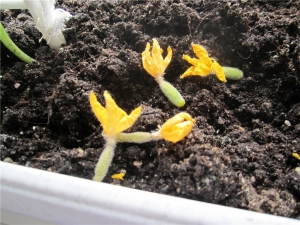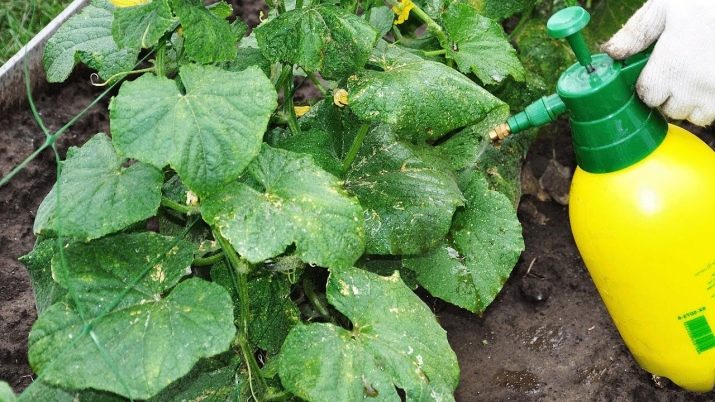Why fall cucumber ovary and what to do?

Growing cucumbers is impossible without quality care for the crop.But sometimes non-observance of the basic rules or neglect of some procedures leads to very bad consequences. For example, the cucumber ovaries simply fall off and, as a result, fruits do not form. What to do in this situation, it is better to clarify in advance.
The reasons
There are several explanations why the cucumber ovary has developmental difficulties. Some of them do not depend on the person himself, and some are just a consequence of ill-conceived care. Usually in such situations, the whole bush begins to look sick, its ovaries turn yellow, dry, and then fall off. As a result, fruiting is significantly deteriorated.
Diseases and viruses
Yellowness and shedding of cucumber ovaries may be a symptom of bacteriosis, which occurs due to the high humidity of the earth and air, and an exceptionally dense planting. This disease, also called “angular spotting,” may appear due to both temperature fluctuations and improper care. Sometimes it all starts with non-compliance with the principle of crop rotation. Bacteriosis can be determined by examining the leaves of the plant: angular spots appear on them, which darken, dry out and form holes in the leaves. In the future, the spots are transferred to healthy neighbors.
Often a healthy plant begins to dry in its upper part. This indicates the occurrence of root rot. The roots cease to develop qualitatively, and therefore, to send nutrients to other parts of cucumbers. Naturally, the ovary also suffers from this. In principle, if you immediately immediately incline the vine to the soil and cover the healthy part of the stalk with earth, then after some time new roots will arise. Additionally, fertilizing them with a mineral complex and getting rid of the impressive part of the ovaries, the plant can be restored.
Improper care
Often the ovary turns yellow, and then dries out when cucumbers do not stepchild in time. Most of the cucumber varieties build up a very large vegetative mass, so it is important to form bushes. It is necessary to eliminate all unnecessary processes that are not within the boundaries of the sinuses of the third and fifth leaves. Those stepchildren who grow higher will need to pinch over the second sheet.
In addition, pinching after the first sheet will be required for those stepchildren who themselves grow up on stepchildren. In this case, the crop will receive enough sunlight to further develop the crop.
Many gardeners are afraid to carry out the staking process, being sure that its absence increases the yield. However, they do not take into account at all that the stepchildren deprive the cucumbers themselves of moisture and nutrients, not allowing new stepchildren and fruits to form. Also, the ovaries deteriorate when cucumbers are planted too tightly. The culture does not have enough space for growth, sunlight and nutrients, which means that vegetables cannot feed their own ovaries. The latter lose their color first, and then fall off. How much it is possible to plant bushes per square meter of beds, usually contained in the instructions on the bag of seeds. Usually in a greenhouse on one square meter should be located no more than two or four bushes.
The excessively frequent feeding of cucumbers with manure, too rare or incorrect during the fruiting period also leads to certain difficulties. Ovaries do not bloom and do not develop when there are no nutrients left in the soil. They also react negatively to excess fertilizer. When fruits are formed, phosphorus with potassium should be added to traditional fluorine and nitrogen. For example, it is recommended to add wood ash and superphosphate dissolved in a liquid to the soil, or to purchase ready-made mineral fertilizer.
Some hybrids elementary can not "feed" all the ovaries. In this case, it is necessary to remove unnecessary formations even before the flowers appear, and remember that one vine will be able to cope with a maximum of thirty fruits.This all happens, because modern hybrids in the axils of virtually every leaf have a ovary, or even more than one. When the ovaries are already growing, but the cucumber itself is not yet sufficiently developed and fully grown, they will begin to fall off. Also, the absence of pollinators from certain varieties may be to blame. If females are not fertilized, then the fruits are practically not tied.
Fall can also occur due to disturbed temperature conditions. For example, the ovary dries in a greenhouse when its temperature exceeds 27 degrees. On the street, cooling to 15 degrees may well occur, as a result of which the ovary will overcool. In both cases, this part of the plant dries, turns yellow and falls. By the way, most often this happens in film greenhouses. They are able to warm up to 40 degrees or even higher in the daytime, and freeze overnight at night.
The most comfortable temperature for cucumbers is that which is in the range from 22 to 24 degrees. If the temperature drops to 13-15 degrees, then the ovary will turn yellow and disappear.
The reason for the fall of the ovaries may be disturbed mode of irrigation, excessive or insufficient. The soil should be filled with water as much as possible, but excessive irrigation is also dangerous. In addition, it should be remembered that before the start of fruiting cucumbers, the humidity of the earth should be slightly higher. Late harvesting may also be a problem. If large cucumbers are still located on the garden, but they are not harvested, then the fruits continue to “consume” the nutrients that should go to the formation of a new crop.
How to fix the situation?
In the case when the blame for the absence of pollinators, they have to attract their own. In the greenhouse, you can open the windows and doors in the daytime, and sprinkle the cucumbers themselves with sweet water, in a liter of which 1 gram of boric acid is dissolved.
You can also place in the greenhouse open dishes with jam or honey water. If the insects lure did not work, for example, because it was overcast or hot and stuffy, then you need to carry out manual pollination. To do this, either the female flower is fanning the male, or the pollen is moved from one to another when using a brush. You can also lean the stamen against the female flower and make the pollen in the desired inflorescence. As a preventive measure, initially, different varieties should be placed so that the males side by side with the females.
If problems arise due to temperature fluctuations, then they need to try to adjust, especially when it comes to the greenhouse. To increase the temperature, you can use a heater or protect the walls with a special foam coating. For the night in the greenhouse it is allowed to place a dark container in which water will be poured. The liquid can accumulate daytime heat, and then “distribute” it at night.
In addition, it is initially recommended to construct a model of wire with a diameter of 2 to 3 millimeters and an apertured film whose thickness reaches 0.5 millimeter. To reduce the temperature, you can spray the film with a solution of clay, flour and chalk. This combination will allow you to reflect excess light. In addition, you should install shields and mats of cane, painted white. This technique will help reduce the effects of infrared radiation. Day soil can be mulched. Finally, morning watering and regular airing will be good.
When the whole problem lies in improper feeding, you should start with the fact that you stop making manure. Instead, the stems are to be sprayed with a solution consisting of a tablespoon of urea and three tablespoons of wood ash, stirred in ten liters of water. From the ready-made fees in the store, you can purchase "Master", "Mortar" or "Crystal."In addition, it is necessary to introduce wood ash in such a way that 300 grams of powder per one square meter of bed.
If the matter is in the wrong watering, then it will have to be normalized. For irrigation, you can use only real water at a comfortable temperature of 23 to 25 degrees, which is by no means cold.
Low temperature not only affects the fall of the ovaries, but also increases the number of male flowers. When it is hot outside, watering occurs in the morning, if it is cold in the afternoon, but not under the scorching sun.
To increase the number of female flowers and slightly dry the soil, at the moment when the ovaries are formed, watering should be suspended for several days. Before flowering, you need to water in such a way that there are about four liters of water per one square meter of bed, and this should be done once a week. When the flowering comes and the fruits appear, watering increases to almost twelve liters per square meter of bed and takes place once every three days.
Preventive measures
In order to comply with agricultural practices, it is necessary to place crops in a greenhouse that is oriented to the cardinal points. If the climate is temperate, then it should be from east to west, and if it is southern, then from north to south.
It is important that a moderate number of shoots also appear on one square meter. The tops pinch so that their length does not extend beyond the boundary of 25 centimeters. Otherwise, the shoots will begin to “take” most of the nutrients from the plant and prevent the ovaries from developing. The sinuses are also “cleaned” in a timely manner, in which unnecessary buds, side shoots and whiskers are placed.
To prevent bacteriosis, cucumbers will need to be periodically sprinkled with a solution of Bordeaux liquid or a suspension of copper oxychloride. Of the finished products, experts recommend "Bayleton", "Aktellik" and sulfur checkers "Climate" and "Fas". When planting, it is necessary to ensure that there is a necessary gap between the bushes, because otherwise too dense thickets will become an excellent basis for the appearance of various diseases.
If the bacteriosis is only the initial stage of development, it is enough to process the cucumbers prepared compositions. If all the cucumbers were destroyed, the bushes should be removed from the soil, and the greenhouse should be fumigated with sulfur blocks.
See why the cucumber ovary does not grow yellow, see below.

































